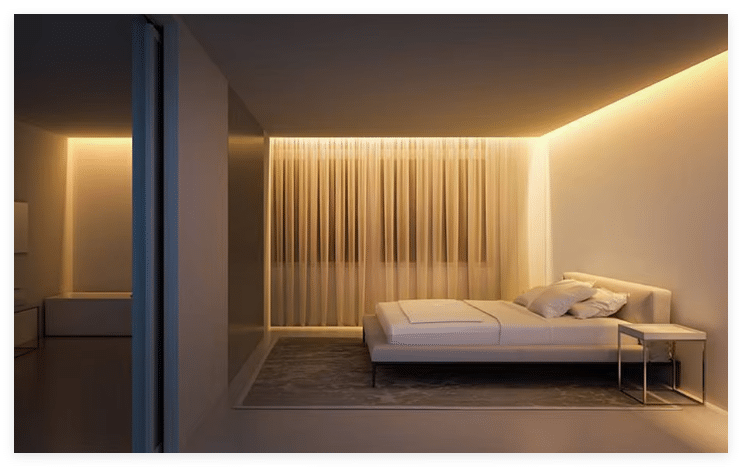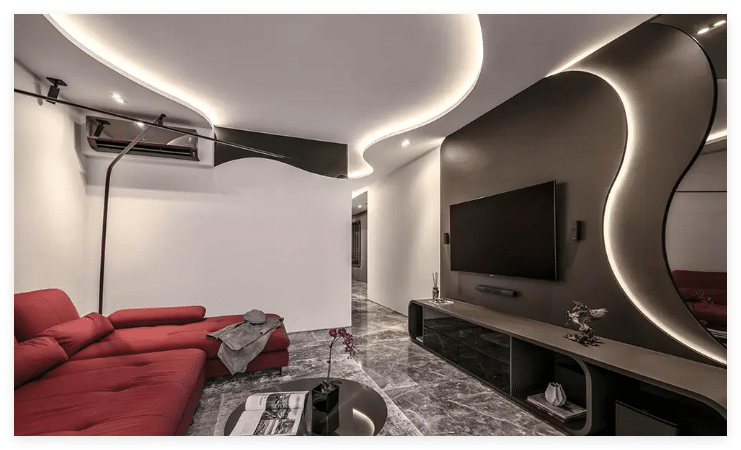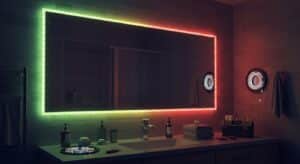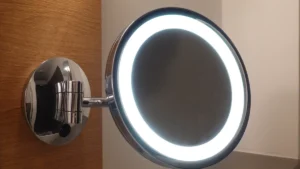
LED strip lights for indirect lighting add a cool look to any space. They are both useful and stylish for modern homes, providing an energy-efficient solution that helps lower electricity bills. For example:
LED strip lights for indirect lighting use up to 80% less energy than old-style lights.
This means you get great lighting while saving money. You can install them almost anywhere, such as under cabinets or behind mirrors, creating a smooth and soft glow. The slim design of LED strip lights for indirect lighting enhances the elegance of rooms, transforming plain spaces into amazing ones.
Key Takeaways
LED strip lights use less energy and lower your bills. They use up to 80% less power than old-style bulbs.
These lights are flexible and can go in many places. They make any room look better.
LED strip lights last a long time, up to 50,000 hours. This means you won’t need to replace them often.
Picking the right brightness and color is important. It helps set the mood in your room.
Smart and dimmable LED strip lights are easy to use. You can change settings to match how you feel.
Benefits of LED Strip Lights for Indirect Lighting
Energy efficiency and cost savings
LED strip lights save energy and cut costs. They turn about 90% of electricity into light, unlike old bulbs that waste energy as heat. This helps lower your bills and reduces how often you need new bulbs. LEDs last 25,000 to 50,000 hours, much longer than the 1,000 hours of regular bulbs.
A University of Michigan study shows LEDs can greatly reduce energy costs. For homes and businesses, the upfront cost of LED strips is worth it. They last long and need little upkeep, making them a smart choice for indirect lighting.
Versatility in design and placement
LED strip lights are very flexible for design and placement. You can put them under cabinets, along ceilings, or behind mirrors for a smooth glow. Their slim shape fits small spaces, improving your room’s look without taking up space.
For instance, one homeowner used warm white LEDs around the ceiling to make their living room cozy. In stores, colorful RGB LEDs create fun displays and better shopping experiences. Picking the right colors and brightness can make any space look amazing.
Aesthetic appeal and ambiance enhancement
LED strip lights are great for setting the mood. You can adjust their colors and brightness for any event. Use them for a relaxed movie night or a lively party.
These lights also make your home look better. They highlight shelves, art, or other features, making your space more stylish. Good LED lighting not only brightens your home but also makes it more welcoming and fun.
Tip: Check the lumens of LED strips to match your brightness needs. More lumens mean brighter light, while fewer lumens give a softer glow.
Long lifespan and low maintenance
LED strip lights last a very long time and need little care. Choosing LED strips means picking lights that work for many years. They usually last about 50,000 hours. If used 10 hours daily, they can shine for over 13 years. With good care, some can even last up to 100,000 hours. This is much longer than old bulbs, which only last 750 to 1,000 hours, or fluorescent lights, which work for 7,000 to 15,000 hours.
LED strip lights are easy to maintain, making them great for busy homes and businesses. They are strong and don’t break easily, so replacements are rare. Cleaning them is simple and keeps them working well. Dust can make them dim, but wiping with a soft cloth brings back their brightness.
Tip: Install LED strips properly and keep them away from extreme heat or water unless they are made for those conditions.
LED strip lights save you time and money while being reliable. They keep your space bright without interruptions. Whether for decoration or lighting large areas, they work well and last long.
How to Pick the Best LED Strip Lights
Thinking About Brightness and Wattage
Picking LED strip lights means knowing about brightness and wattage. Indirect lighting should feel cozy, not too bright. To get this, aim for the right brightness, not the highest.
Here are some tips to help:
Buy good-quality LED strips from trusted brands. Cheap ones might not be as bright as promised.
Check lumens per watt for efficiency, but also think about comfort and avoiding glare.
Ask yourself, “How much light is enough?” Softer light usually works better for indirect lighting.
By keeping these in mind, your LED strips can light up your space without being too strong.
Picking the Best Color Temperature
Color temperature affects how a room feels. It’s measured in Kelvin (K) and shows if the light looks warm, neutral, or cool. Your choice depends on the mood you want and how you’ll use the space.
Color Temperature | What It Looks Like | Best For |
|---|---|---|
Ultra-Warm (1800-2700K) | Soft like candlelight | Nightstands, headboards, cozy spots |
Warm (2700-3500K) | Like old bulbs, comfy | Bedrooms, living rooms |
Neutral (4000-4500K) | Bright white, like daylight | Kitchens, study areas |
Cool (5000-6500K) | Bluish, keeps you alert | Offices, bathrooms, schools |
Ask yourself:
What mood do I want in this room?
Which colors or items should stand out?
What color temperature fits my project best?
Answering these will help you pick the perfect LED strip lights.
Waterproof or Non-Waterproof Choices
Deciding between waterproof and non-waterproof LED strips depends on where you’ll use them. Waterproof ones handle moisture well, so they’re great for wet places. Non-waterproof strips work better indoors.
Think about these points:
Durability: Waterproof strips last longer in wet spots. Non-waterproof ones might not handle humidity well.
Price: Waterproof strips cost more because of their protection. Non-waterproof ones are cheaper for indoor use.
Ease of Use: Waterproof strips are thicker and harder to fit in small spaces. Non-waterproof ones are easier to install.
Use waterproof strips in bathrooms, patios, or kitchens. For bedrooms, offices, or living rooms, non-waterproof strips are usually enough.
Dimmable and smart LED strip lights
Dimmable and smart LED strip lights give you easy control. You can change brightness to fit any mood or activity. Use a soft light to relax or brighter light to focus. These lights let you adjust them to match what you need.
Smart LED strip lights offer even more features. You can control them with apps or voice commands. They work with systems like Alexa, Google Home, or Apple HomeKit. This means you can change colors or brightness without getting up. Smart LED strips make lighting super convenient.
Here’s why dimmable and smart LED strips are better than regular ones:
Benefit | Description |
|---|---|
Energy Efficiency | They use less power than old-style lights. |
Customization | You can change colors and install them in many ways. |
Integration with Smart Homes | They connect to smart home systems for more convenience. |
Market Growth | More people want them because of smart home popularity. |
Applications | Great for mood lighting, accents, and fun setups. |
These LED strips give steady light, keeping your space evenly bright. They’re perfect for mood lighting, accents, or even fun entertainment setups. By choosing these lights, you save energy and enjoy modern features.
Tip: Add motion sensors to smart LED strips for lights that turn on when you enter a room.
Creative Ideas for Indirect Lighting

Under-cabinet lighting
Under-cabinet lighting makes your kitchen both useful and stylish. LED strip lights give a soft glow, helping you see better while cooking or chopping. Their thin design fits neatly under cabinets, giving your kitchen a clean, modern look.
Pick warm white LEDs for a cozy feel or cool white for brighter light. Dimmable LED strips let you change the brightness. Use bright light for cooking and softer light to relax in the evening.
This lighting also makes your kitchen look more interesting. It highlights countertops and backsplashes, making them stand out. Under-cabinet lighting is both practical and beautiful, improving your kitchen easily.
Tip: Use waterproof LED strips in areas with spills or moisture for longer-lasting lights.
Cove lighting for ceilings and walls
Cove lighting adds a fancy and classy touch to any room. Place LED strip lights in hidden spots along ceilings or walls. This creates a soft glow that shows off your room’s design.
Studies show LED cove lighting has many benefits:
Benefits of LED Cove Lighting | Things to Think About Before Installing |
|---|---|
Saves energy and works in many spaces | Where to place the cove |
Can be designed in different ways | Which LED strips to pick |
Lets you dim the lights | The light’s color temperature |
Lasts longer than old-style bulbs | Getting expert help for setup |
When setting up cove lighting, think about where to put it and which LEDs to use. Warm white lights make a room feel calm, while cooler tones suit modern designs. Install them carefully to spread light evenly without harsh shadows.
Accent lighting for shelves and displays
Accent lighting makes shelves and displays stand out in your room. LED strip lights work well because they’re flexible and don’t get hot.
Here are some fun ideas for accent lighting:
Add LED strips to open or glass shelves in kitchens. This gives light for tasks and makes the shelves look nice.
Light up built-in shelves in bedrooms to improve the room’s style.
Use LED strips behind artwork for a dramatic look. They won’t damage the art since they don’t get hot.
Accent lighting makes your space look more exciting and adds depth. Try different colors and brightness levels to match your room’s vibe.
Note: Pick LED strips with adjustable brightness to change the light for different events.
Backlighting for TVs and mirrors
Adding backlighting to TVs and mirrors improves looks and usefulness. Placing LED strip lights behind your TV reduces eye strain. The soft light lowers the contrast between the screen and dark room. This makes watching TV more comfortable. For mirrors, backlighting adds a fancy and modern feel. It also helps you see better for grooming or makeup.
When picking LED strips, think about brightness levels. Use this table to choose the right lumens per foot:
Lighting Purpose | Lumens per Foot |
|---|---|
Low accent lighting | 80-100 |
Brighter accents and low ambient | 150-300 |
Higher-medium ambient or medium task | 300-400 |
Ambient or task lighting | 350-500 |
Large commercial bathroom | 700+ |
For mirrors, choose LEDs with a high Color Rendering Index (CRI). A CRI of 90 or more shows colors correctly. This is important for tasks like applying makeup. Low CRI lights make colors look dull and less clear.
Tip: Use dimmable LED strips for TVs and mirrors. You can change the brightness for different times or activities.
Backlighting makes your space look stylish and useful. With the right LED strips, you can create a sleek and functional design.
Staircase and hallway lighting
LED strip lights make staircases and hallways safer and more stylish. Good lighting helps you see better, lowering the chance of trips or falls. Place LED strips along steps or under handrails to light each step. This makes it easier to walk in the dark. In hallways, LED cove lights give a soft glow. They save space and make the area feel welcoming.
Check this table for recommended lighting levels:
Area | Recommended Lighting Level | Notes |
|---|---|---|
Hallways | 100-150 lux | Use LED cove lights for saving space and energy. |
Stairs | At least 100 lux | Light steps clearly to avoid falls. |
Color Temp | Around 3,000K | Reduces glare and improves visibility on stairs. |
For stairs, warm white LEDs (about 3,000K) create a cozy feel and improve safety. In hallways, motion-activated LED strips are a smart choice. They save energy and add convenience.
Note: Place LED strips carefully to avoid glare and spread light evenly.
Using LED strip lights in staircases and hallways boosts safety and style. These lights are a practical and attractive way to brighten busy areas in your home.
Installation Tips for LED Strip Lights
Tools and Materials Needed
To install LED strip lights, you need the right tools. These tools make the process safe and easy. Here’s a simple table of what you’ll need:
Tools | Skills You’ll Need |
|---|---|
Voltage detector | Know basic electricity and wiring rules |
Wire strippers | Understand simple electrical diagrams |
Wire cutters | Pick the right LED lights for your project |
Wire nuts | Measure, cut, and route wires correctly |
Electrical tape | Install switches and outlets properly |
Screwdriver | Follow safety rules for electrical work |
Drill | No special skills needed |
Hammer | No special skills needed |
Ladder | No special skills needed |
Having these tools ready makes installation faster and safer. Always check wires with a voltage detector before starting to stay safe.
Step-by-Step Installation Guide
Follow these easy steps to set up your LED strip lights:
Learn about different LED strips, like analog or digital, and their wiring needs.
Figure out how much power you need and pick the right power supply.
Cut the LED strips to the length you want at marked spots.
Connect the strips using connectors or soldering, making sure they line up.
Wire the strips based on their voltage, like using a MOSFET for 12V strips.
Stick the strips onto a clean surface with adhesive or mounting clips.
These steps will help you install your LED strips neatly and make sure they work well.
Common Mistakes to Avoid
Avoid these mistakes to make sure your LED strip lights work perfectly:
Clean the surface before sticking the strips to avoid peeling.
Use good-quality connectors to prevent electrical issues.
Measure carefully before cutting to avoid mistakes.
Only cut the strips at marked spots to avoid damage.
Use waterproof strips in wet or outdoor areas.
Add dimming options for more control over brightness.
Ask a professional for help if you’re unsure about any step.
By avoiding these errors, you’ll save time and money. Your LED strip lights will look great and work just as you want them to.
Tips for hiding wires and achieving a clean look
Messy wires can make your LED strip lights look bad. Keeping them hidden makes everything look neat. Here are some easy tips to help you manage wires well:
Use cable management tools: Cable clips, zip ties, and sticky wire holders keep wires tidy. Stick them along furniture edges or walls to hide them.
Conceal wires with channels: Plastic or metal channels are great for hiding wires. You can paint them to match your wall color, so they blend in.
Route wires behind furniture: Put wires behind cabinets, shelves, or other furniture. This keeps them hidden without needing extra tools.
Shorten excess wire: Cut wires to the right length or bundle extra neatly. Don’t leave long, tangled wires out.
Tip: Always check the maker’s instructions before cutting wires to avoid breaking your LED strip lights.
For a fancier look, try these advanced ideas:
Install recessed outlets: Put outlets closer to your LED strips to hide wires better.
Use baseboards or crown molding: Hide wires behind these features for a smooth look.
Hide wires in drywall: For a lasting fix, run wires through the wall. This needs careful planning and might need expert help.
Note: When hiding wires, make sure they can be reached for fixing or checking. Don’t bend them too much to avoid breaking.
By following these tips, you can make your LED strip lights look neat and tidy. A well-organized setup not only looks good but also keeps things safe and working well.
LED strip lights for indirect lighting have many benefits. They use less energy, last longer, and make spaces look better. You can use them in creative ways, like lighting up mirrors or shelves. They work well in cozy living rooms or stylish kitchens.
Setting them up is easy, even for beginners. You can pick dimmable or smart options to match your needs. Try these lights to turn your space into something amazing.
FAQ
Where can I put LED strip lights for indirect lighting?
Place LED strip lights under cabinets, on shelves, or behind mirrors. You can also add them along ceilings for a soft glow. For safety, use them on stairs or in hallways.
Tip: Pick waterproof LED strips for wet areas like bathrooms or kitchens.
How do I pick the right brightness for LED strip lights?
Choose brightness based on how you’ll use the room. Accent lighting needs 80-150 lumens per foot. Task lighting works best with 300-500 lumens. Check lumens ratings to avoid lights that are too bright.
Can LED strip lights be trimmed to fit spaces?
Yes, you can cut most LED strips at marked spots. Use scissors or a cutting tool to trim them. Follow the maker’s instructions to keep them working.
Note: Only cut at marked lines to avoid breaking the strips.
Are LED strip lights safe to use?
LED strip lights are safe if installed properly. They stay cool and use low voltage, lowering fire risks. Use the right power supply and don’t overload circuits for extra safety.
Can LED strip lights connect to smart home systems?
Yes, many LED strips work with smart systems like Alexa or Google Home. You can change colors, brightness, or schedules using apps or voice commands. This makes them easy and modern to use.
See Also
Versatile COB LED Strips for Unique Design Projects
Selecting the Perfect LED Strip Lights for Linear Lighting
Best Reviewed COB LED Strip Lights for 2025



